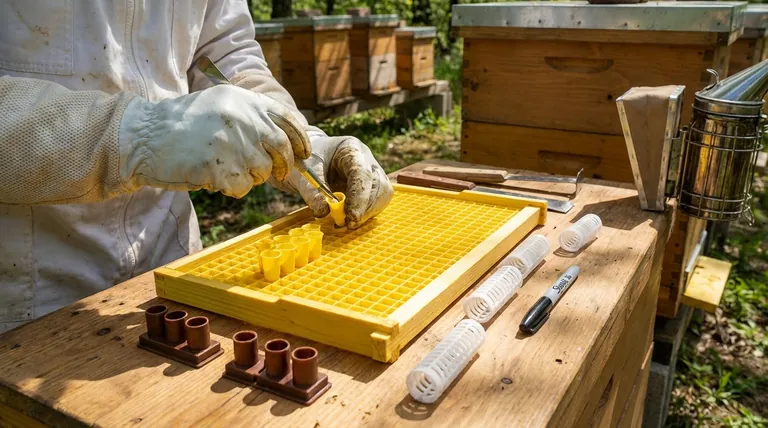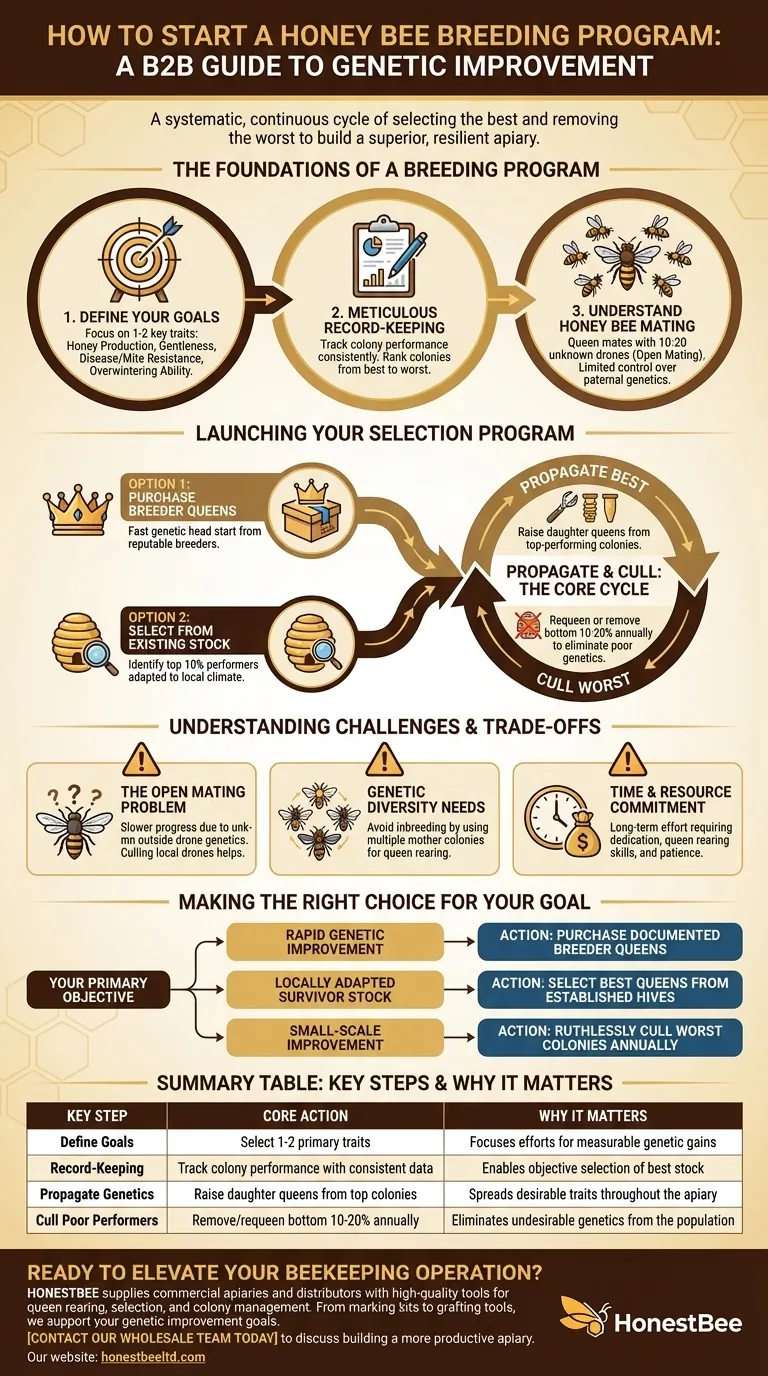Starting a honey bee breeding program is a systematic process of genetic improvement for your apiary. It begins by either purchasing queens with proven, desirable traits or identifying and propagating the best genetics from your existing stock. The core of any successful program is the disciplined practice of culling—removing queens or entire colonies with unacceptable traits to prevent their genes from passing to the next generation.
An effective breeding program is not a one-time action but a continuous cycle of selection and removal. Your success depends on consistently identifying and propagating your best colonies while systematically eliminating your worst, all while navigating the unique complexities of honey bee mating.

The Foundations of a Breeding Program
Before you can improve your bees, you must define what "better" means for your specific operation and environment. A successful program integrates clear goals with rigorous management and a basic understanding of bee genetics.
Define Your Breeding Goals
The first step is deciding which traits are most valuable to you. Selection is a game of focus; trying to improve everything at once often results in improving nothing.
Common traits to select for include honey production, gentleness, disease and mite resistance (like Varroa Sensitive Hygiene or VSH), and overwintering ability. Choose one or two primary traits to start.
The Critical Role of Record-Keeping
You cannot select for traits you do not measure. Meticulous record-keeping is the backbone of any breeding program.
Track each colony's performance against your chosen goals. Simple notes on a hive lid or a detailed spreadsheet can work, as long as the data is consistent and allows you to rank your colonies from best to worst.
Understanding Honey Bee Mating
Breeding honey bees is uniquely challenging compared to other livestock. A queen bee's genetics are only half the equation.
She mates in the air with 10-20 different drones from various colonies in the surrounding area. This "open mating" means you have limited control over the paternal genetics, making selection and culling within your own operation even more critical.
Launching Your Selection Program
With your goals defined, you can begin the practical cycle of identifying, propagating, and culling your stock. This process is iterative and requires patience.
Option 1: Purchase Breeder Queens
The fastest way to introduce high-quality genetics is to buy queens from a reputable breeder known for the specific traits you desire.
This gives you a genetic head start. These queens become your "breeder colonies," from which you will raise new daughter queens to requeen your other hives.
Option 2: Select From Your Existing Stock
Alternatively, you can work with what you have. Identify your top 10% of colonies based on your records—the ones that best exhibit your target traits.
These bees are already adapted to your local climate and forage, which is a significant advantage. These top-performing colonies become the source for your next generation of queens.
The Core Action: Propagate and Cull
Once you've identified your best colonies, you must propagate their genetics, typically by rearing daughter queens from them.
Simultaneously, you must be disciplined about culling your worst performers. Requeening or completely removing the bottom 10-20% of your colonies each year is essential. This action removes poor genetics from your apiary and reduces the number of undesirable drones in your local mating pool.
Understanding the Trade-offs and Challenges
A breeding program is a powerful tool, but it is not without its difficulties. Understanding these challenges is key to long-term success and avoiding common pitfalls.
The Open Mating Problem
As mentioned, your selected virgin queens will mate with unknown local drones. This means progress can be slower than in other forms of animal breeding, as outside genetics are constantly being introduced.
Consistent culling of nearby colonies helps improve the quality of the local drone population over time, but it will never be a closed system without instrumental insemination.
The Need for Genetic Diversity
Focusing on too few breeder queens can lead to inbreeding, which can result in poor brood viability and weakened colonies.
Always aim to raise new queens from several of your top-performing "mother" colonies, not just one. This maintains the genetic diversity crucial for a healthy and resilient apiary.
The Commitment of Time and Resources
A breeding program is a long-term commitment, not a quick fix. It requires dedication, consistent record-keeping, and the skill of queen rearing.
Results are not seen in a single season but are gradually realized over several years of consistent selection pressure.
Making the Right Choice for Your Goal
Your approach should match your primary objective. There is no single "best" way to begin; there is only the best way for your operation.
- If your primary focus is rapid genetic improvement: Start by purchasing breeder queens with documented high-performance traits to accelerate your progress.
- If your primary focus is creating locally adapted survivor stock: Begin by rigorously selecting the best-performing queens from your own established, overwintered colonies.
- If you are a small-scale beekeeper: Concentrate your efforts on ruthlessly culling your worst colonies each year to steadily improve the average genetic quality of your apiary.
Ultimately, a systematic approach to selection and culling is what transforms simple beekeeping into a strategic breeding program that builds a superior and more resilient apiary.
Summary Table:
| Key Step | Core Action | Why It Matters |
|---|---|---|
| Define Goals | Select 1-2 primary traits (e.g., honey production, disease resistance). | Focuses efforts for measurable genetic gains. |
| Record-Keeping | Track colony performance with consistent data. | Enables objective selection of your best stock. |
| Propagate Genetics | Raise daughter queens from top-performing colonies. | Spreads desirable traits throughout the apiary. |
| Cull Poor Performers | Remove or requeen the bottom 10-20% of colonies annually. | Eliminates undesirable genetics from the population. |
Ready to elevate your beekeeping operation with a professional breeding program?
HONESTBEE supplies commercial apiaries and beekeeping equipment distributors with the high-quality tools and supplies needed for successful queen rearing, selection, and colony management. From marking kits to grafting tools, we support your genetic improvement goals.
Contact our wholesale team today to discuss how our equipment can help you build a more productive and resilient apiary.
Visual Guide

Related Products
- Jenter Queen Rearing Kit Complete Set for Bee Breeding
- No Grafting Queen Rearing Kit: System for Royal Jelly Production and Queen Rearing
- Nicot Queen Rearing Kit for Beekeeping and Grafting in Nicot System
- Brown Nicot Queen Cell Cups for Breeding Queen Bees Beekeeping
- Wooden Queen Bee Excluder for Beekeeping
People Also Ask
- What were the size differences among queens reared from worker larvae? Maternal Origin Determines Queen Size
- What is the timeline for queen breeding? A 28-Day Guide from Egg to Laying Queen
- What is queen rearing in beekeeping? Take Control of Your Apiary's Genetics
- What are the stages involved in queen raising? A Guide to Controlled, High-Quality Queen Production
- What are the implications of delayed oviposition in queen bees? A Strategy for Superior Queen Quality



















